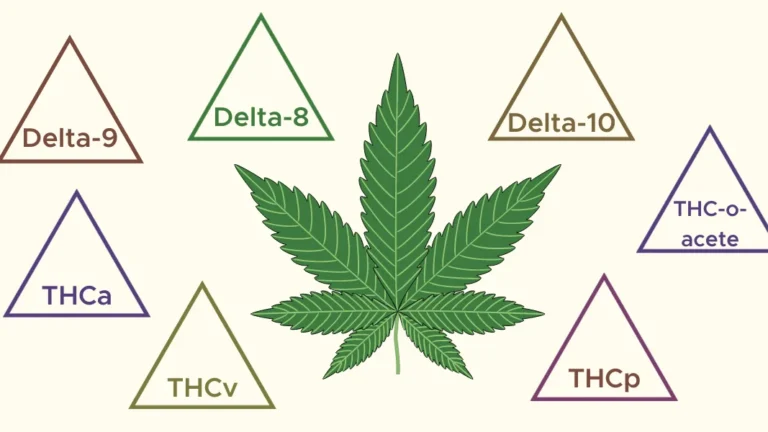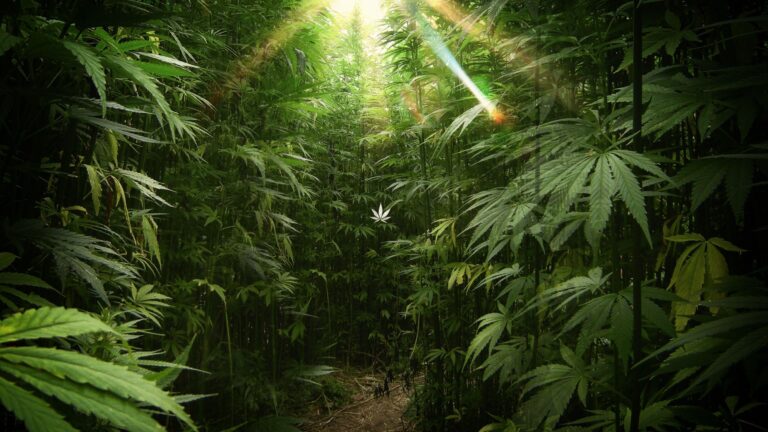
The Cannabis Gender Divide: Why Male Cannabis Plants Are a Grower’s Nemesis
In the vibrant world of cannabis cultivation, the distinction between male and female weed plants is a game-changer. Female plants are the superstars, producing the resinous, THC-rich buds that fuel both recreational and medicinal cannabis use. In contrast, male cannabis plants churn out pollen that can derail a grower’s dreams by pollinating females, leading to seeded, less potent buds.
Whether you’re a novice grower or a seasoned cultivator, understanding male vs female cannabis plants is essential for maximizing yield and quality. This comprehensive guide explores how to tell male from female cannabis plants, highlights the early signs of female plants, and dives into the differences between male and female marijuana plants. Get ready to master the art of cannabis gender identification and unlock the secrets to superior buds.
Understanding Cannabis Plant Gender
Cannabis is a dioecious species, meaning it typically has separate male and female plants, each with distinct reproductive roles. Female plants produce buds packed with cannabinoids like THC and CBD, as well as aromatic terpenes, making them the primary focus for most growers. Male plants, however, produce pollen sacs that release pollen to fertilize females, resulting in seed production. While this is valuable for breeding, it’s a setback for growers seeking seedless (sinsemilla) buds, which are more potent and desirable.
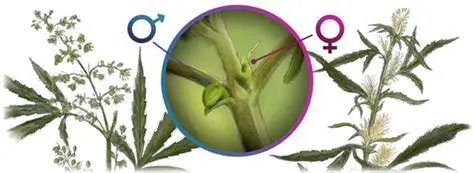
Occasionally, cannabis plants can be hermaphroditic, developing both male and female traits due to genetics or environmental stress, such as light leaks or nutrient imbalances. These hermaphrodites can self-pollinate or pollinate other females, complicating cultivation efforts. Understanding these gender dynamics is critical for any grower aiming to produce high-quality cannabis.
Physical Differences: Male vs. Female Cannabis Plants
The male vs female weed plant distinction is most apparent in their reproductive structures and growth patterns. Here’s a detailed comparison:
| Aspect | Male Cannabis Plant | Female Cannabis Plant |
|---|---|---|
| Reproductive Role | Produces pollen sacs for fertilization | Produces buds; can be fertilized to produce seeds |
| Appearance | Taller, lankier, fewer leaves | Bushier, denser foliage |
| Flowers | Small, bell-shaped pollen sacs | Teardrop-shaped buds with white pistils |
| Cannabinoid Content | Trace amounts of THC/CBD | High THC/CBD in buds |
| Purpose | Breeding, fiber, or minor concentrate use | Bud production for smoking, edibles, extracts |
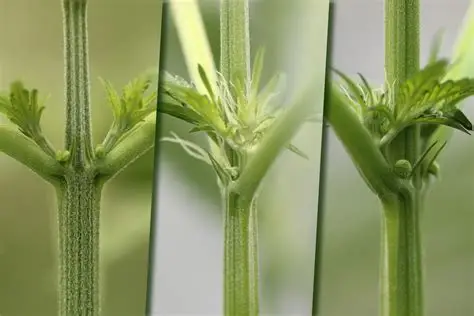
- Male Plants: Often grow taller with fewer leaves and develop small, round pollen sacs at the nodes (where branches meet the stem). These sacs burst open at maturity, releasing pollen that can travel far to fertilize females.
- Female Plants: Tend to be shorter and bushier, with dense foliage. They develop white, hair-like pistils at the nodes, which form into resinous buds covered in trichomes—the glands that produce cannabinoids and terpenes.
These differences, as noted by Leafwell, make female plants the preferred choice for most cultivators, while males are typically removed unless needed for breeding.
Early Signs of Female Plants
Identifying the sex of cannabis plants early can save growers time and resources. The key is to look for pre-flowers, which appear during the vegetative stage, typically 4-6 weeks after germination:
- Female Pre-Flowers: Small, white, hair-like structures (pistils) emerge from the nodes, often accompanied by a teardrop-shaped calyx. These are the early signs of female plants and indicate future bud development.
- Male Pre-Flowers: Tiny, ball-shaped structures form at the nodes, resembling small grapes. These will develop into pollen sacs if left to mature.
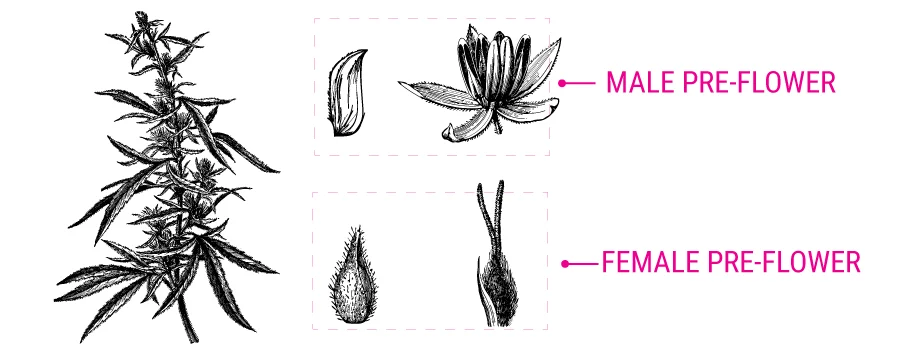
Using a magnifying glass or jeweler’s loupe can help spot these subtle signs, as advised by Grow Weed Easy. Early identification allows growers to remove males before they pollinate, ensuring females focus on producing potent buds.
Why Distinguishing Male and Female Plants Matters
The male vs female cannabis distinction is critical for several reasons:
- Preventing Pollination: If a male marijuana plant pollinates a female, the female diverts energy from producing THC-rich resin to developing seeds. This results in seeded buds, which are less potent and less desirable for consumers, as highlighted by CannaMD.
- Maximizing Yield and Quality: Unpollinated female plants (sinsemilla) produce larger, denser buds with higher cannabinoid and terpene content, making them ideal for smoking, edibles, or extracts.
- Breeding Control: For growers interested in creating new strains, keeping males separate allows controlled pollination to produce seeds with desired traits.
Failing to identify and remove males can ruin an entire crop, reducing both yield and potency, as emphasized in a Reddit post.
The Hermaphrodite Challenge
Some cannabis plants develop both male and female reproductive organs, becoming hermaphrodites. This can occur due to:
- Genetics: Certain strains are more prone to hermaphroditism.
- Environmental Stress: Factors like irregular light cycles, nutrient deficiencies, or physical damage can trigger female plants to develop male flowers as a survival mechanism.
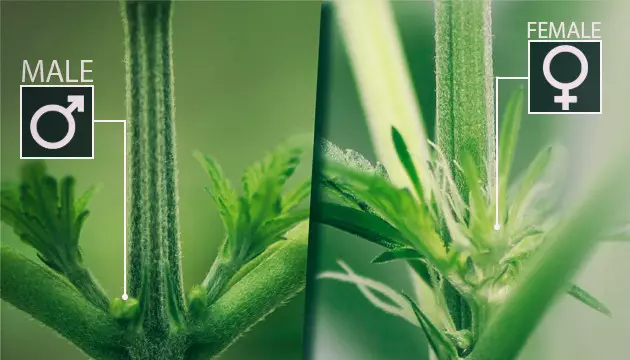
Hermaphrodites are problematic because they can self-pollinate or pollinate nearby females, leading to seeded buds. To manage them:
- Monitor Closely: Check for both pistils and pollen sacs on the same plant.
- Remove Promptly: If hermaphrodites are detected, remove them immediately to protect your crop, unless you’re breeding intentionally.
Homestead and Chill recommends vigilant monitoring to catch hermaphrodites early.
Uses of Male Cannabis Plants
While male pot plants are often discarded, they have niche applications:
- Breeding: Males are essential for pollinating females to create new strains or seeds with specific traits, such as high THC or unique flavors.
- Concentrates: Though less common, male plants can be used to make hash or other concentrates, but their low THC content makes them less effective than females, as noted by Leafwell.
- Hemp Production: In industrial hemp cultivation, male plants are valued for their strong fibers, used in textiles or other products, due to their taller, sturdier structure.
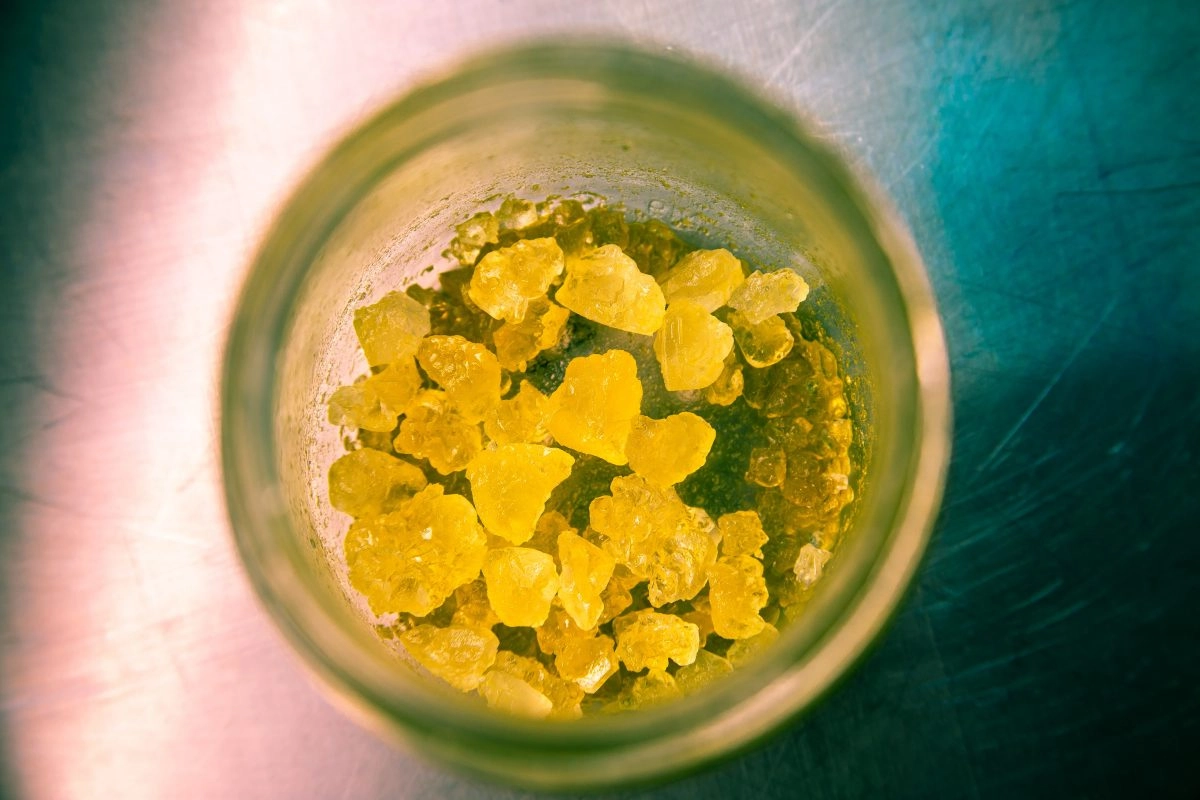
For most growers focused on bud production, however, males are removed to prioritize female plants.
Best Practices for Growers
To optimize your cannabis grow and ensure high-quality buds, follow these strategies:
- Use Feminized Seeds: These seeds are genetically engineered to produce only female plants, eliminating the risk of males, as recommended by Grow Weed Easy.
- Inspect Regularly: Check plants daily during the vegetative stage (4-6 weeks) for pre-flowers to identify and remove males early.
- Isolate Males for Breeding: If breeding, keep males in a separate, sealed grow space to prevent accidental pollination.
- Minimize Stress: Maintain stable light, nutrient, and environmental conditions to reduce the risk of hermaphroditism.
- Use Magnification Tools: A loupe or magnifying glass can help identify pre-flowers accurately, especially in young plants.
FAQ: Common Questions About Male and Female Cannabis Plants
- Can male cannabis plants get you high?
Male plants contain trace amounts of THC, far too low to produce psychoactive effects. They’re not used for consumption but can be used for breeding or minor concentrates. - What should I do with male cannabis plants?
Remove them immediately to prevent pollination, unless you’re breeding or using them for hemp fiber or concentrates. - How early can I tell if a plant is male or female?
Pre-flowers appear 4-6 weeks after germination, allowing early sex identification. Males often show pre-flowers slightly earlier than females. - What happens if I don’t remove male plants?
Males will pollinate females, leading to seeded buds with lower THC content and reduced quality.
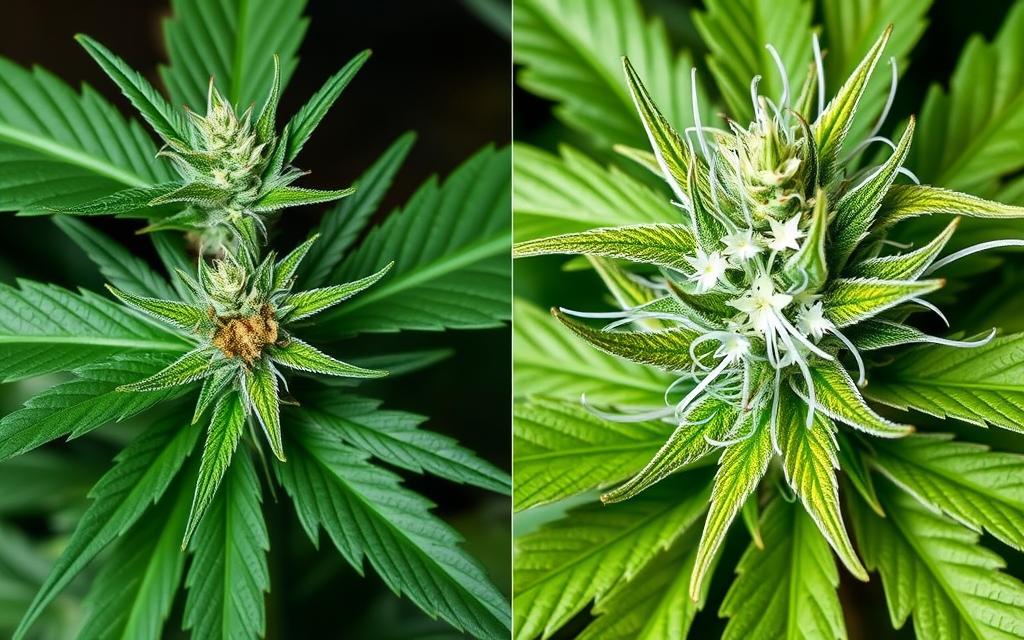
Final Thoughts
The male vs female pot plant distinction is a cornerstone of successful cannabis cultivation. By mastering how to tell male from female cannabis plants, recognizing the early signs of female plants, and understanding the risks posed by males and hermaphrodites, growers can ensure a bountiful harvest of potent, seedless buds. Whether you choose feminized seeds or vigilantly monitor your plants, prioritizing female plants is the key to unlocking superior cannabis quality. Dive into your grow with confidence, and let your female plants shine.
Citations:
- Leafwell: Female vs. Male Weed Plants
- WikiHow: How to Identify Female and Male Marijuana Plants
- CannaMD: Cannabis Plant Gender
- Alchimia Grow Shop: How to Distinguish Marijuana Males from Females
- My Florida Green: Male Cannabis Plant vs. Female
- Grow Weed Easy: Male vs Female Cannabis Plants
- Homestead and Chill: Sexing Cannabis
- Reddit: Male vs. Female Cannabis Plants
- Grow Weed Easy: How to Tell Sex of Cannabis Plants
- Hey Abby: Identifying Female vs Male Weed Plants

